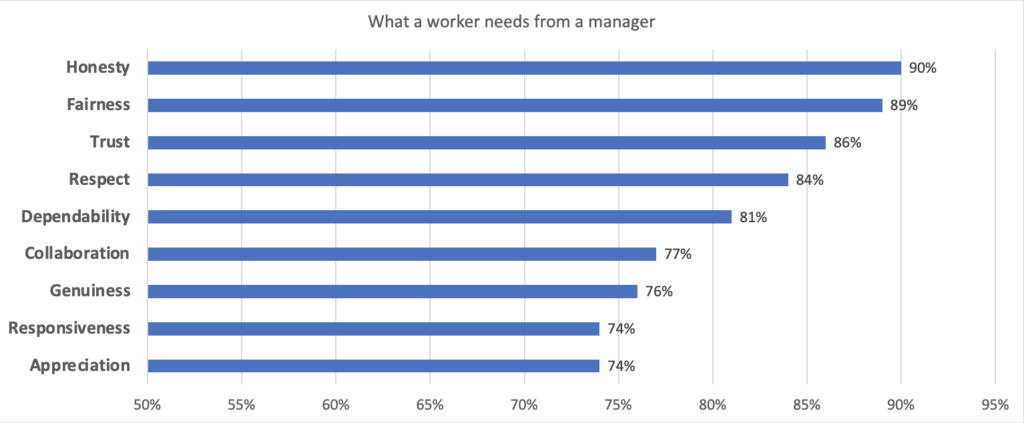A Few Facts about Turnover
According to the US Bureau of Labor Statistics, the 2020 annual separations rate in wholesale trade was 37.4, and in finance and trade, it was even lower at 25.1. Both of those figures represented significant increases year-over-year, due at least in part to ongoing labor shortages. They are less striking, however, than the rate of employee turnover that we are seeing in the manufacturing sector – a rate that ought to give pause to anyone who is trying to build a business within the sector.
Manufacturing turnover is 44.3[1]. This rate, no matter how we try to spin it, likely reflects sector-wide shortcomings on multiple levels. When manufacturing firms are failing en masse to retain their employees, it becomes a major hindrance to stability, let alone growth.
Turnover impacts a manufacturer in many ways. A recent report[2] by Tooling U-SME, an organization that provides training solutions to manufacturing firms noted some of the largest costs of turnover, including: opportunity costs due to smaller capabilities, “brain drain” in the form of skill and insight loss, and morale decline.
Turnover also has a direct impact on efficiency, upon which manufacturing firms rise and fall. When a firm is unable to keep employees happy and productive, output falls. That is what we are watching in action here: every time a firm sustains the damages of turnover, its position in the sector weakens.
Finally, the economic costs of turnover can be devastating. The costs to source candidates are escalating, wages are rising, and opportunity costs are rising. It is worth asking ourselves why the rate of employee turnover is exceptionally high in the manufacturing sector.
What is Happening?
Manufacturing jobs are not as attractive as in the past. The National Association of Manufacturers and the Manufacturing Institute concluded that a mere 30% of parents “would consider guiding their child toward a career in the field.” This environment makes it even more important to retain the resources you hire. This requires a review of what is happening on a more personal level – and what leadership within the firms can do to make a difference for their teams.
Supervisors are the key to employee retention. Managers are responsible for 70% of employee engagement, according to a recent Gallup poll[3]. This likely comes as no surprise to anyone who has ever heard the saying “People leave leaders, not jobs.” Bad managers, it would seem, are the aggravating factor in higher rates of employee turnover. Improved retention requires better training when we place and prepare managers.
Gallup also found that when companies made decisions about promotions or new hires in management, they “got it wrong” 82% of the time[4]. Their report pointed to the reasons that companies chose managers: tenure and success in a technical role. Neither of these reasons serves as an accurate predictor of leadership skills or of management ability. Too often, companies determine leaders based on a misconception of the critical skills needed.
Making the Right Changes
Fortunately, there is little mystery about what it means for managers to serve in their roles effectively – at least from their employees’ perspectives. In his book What People Want, Terry Bacon presented workers’ most pressing needs. They were, in order of popularity:

A worker’s most pressing needs in a manager, data from What People Want, by Terry Bacon
Honesty (90%), Fairness (89%), Trust (86%), Respect (84%), Dependability (81%), Collaboration (77%), Genuineness (76%), Appreciation (74%), Responsiveness (74%)
These needs are signposts that guide us toward the skills managers need most: empathy, listening, and social acuity, not technical proficiency. When a manager is capable of hearing his or her employees, solving their problems and recognizing their efforts, the warehouse or facility becomes a more positive environment for all employees, who will feel more inclined not only to stick around but to work harder as well.
It may sound as if good management is more a talent than a skill. Dr. Helen Reiss of Harvard Medical School has presented research showing, on the contrary, that people learn and unlearn empathy constantly. As part of her studies, she conducted neurological imaging on physicians, to illustrate the changes in brain activity while they were undergoing training (and losing empathy) as well as while they were practicing medicine (and regaining it). Similarly, your supervisors can learn these critical leadership skills quickly. Workers have again done us the favor of letting us know what they want most from their employers: education, by a wide margin, according to a recent study by LinkedIn[5].
A real and lasting impact on employee turnover in manufacturing will only happen when firms examine the processes they use to prepare and constantly upgrade their managers.
About Whistle
Whistle is the first learning platform to integrate the key elements of behavior change – ability (microlearning), motivation (micropayments and recognition), cues (AI informed nudges and recommendations) while removing friction (simplified design and mobile centric approach). Together these multiply the impacts of microlearning to maximize the impact on business outcomes.
End notes
[1] Association for Manufacturing Excellence
[2] The True Cost of Turnover: Hidden Costs Go Beyond Financial to Impact Productivity and Culture
[3] Source
[4] State of the American Manager: Analytics and Advice for Leaders
[5] https://learning.linkedin.com/resources/workplace-learning-report
Sources
https://www.bls.gov/news.release/jolts.t16.htm
https://www.toolingu.com/About/Press-News/Tooling-U-SME-Looks-at-the-True-Cost-of-Turnover
https://news.gallup.com/businessjournal/182792/managers-account-variance-employee-engagement.aspx
https://news.gallup.com/businessjournal/187871/leadership-mistake-promoting-based-tenure.aspx
https://sescomgt.com/resources/articles/nine-things-employees-want-from-their-managers/138
https://learning.linkedin.com/resources/workplace-learning-report









